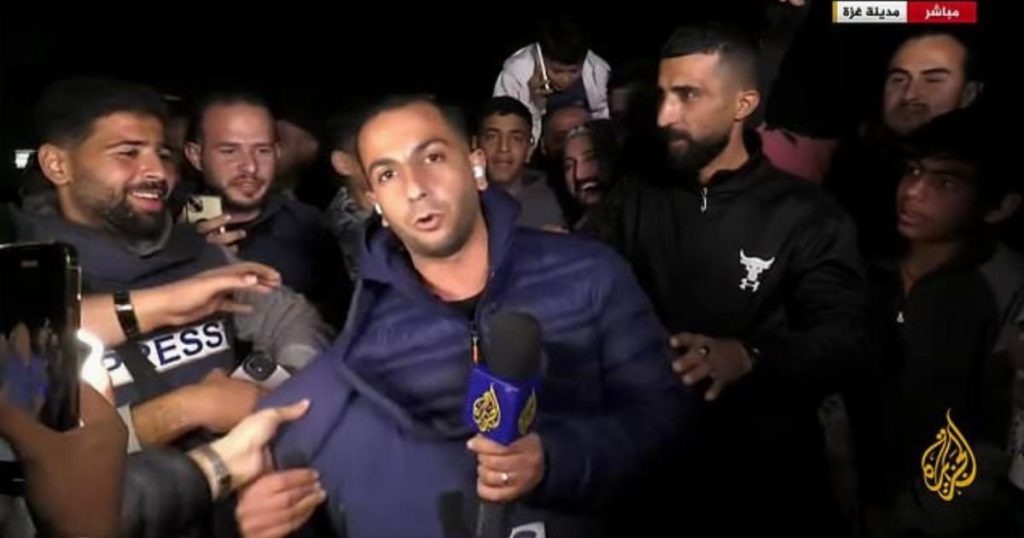The poignant image of Palestinian journalist Anas Al-Sharif removing his battle-worn body armor after 15 grueling months of reporting from the Gaza Strip has resonated deeply, symbolizing the collective exhaustion and relief felt by Palestinians following the announcement of a ceasefire between Hamas and Israel. The 28-year-old Al Jazeera reporter’s emotional act, captured in a widely circulated video, encapsulates the precarious and often life-threatening conditions faced by journalists covering the protracted conflict. His simple words, expressing the weight of the armor that had become “a part of his body,” underscore the constant threat of violence that permeated daily life in Gaza. The cheers of “Allahu Akbar” that erupted as he removed the helmet and vest mirrored the jubilant hope for an end to the devastating war that has claimed tens of thousands of lives and left Gaza in ruins.
The ceasefire agreement, brokered by Qatar, marks a potential turning point in the deadliest conflict ever witnessed between Israel and Hamas. For over a year, the relentless bombardment of Gaza has transformed the once-vibrant coastal enclave into a landscape of devastation, characterized by bombed-out buildings, mountains of rubble, and a pervasive sense of despair. The sheer scale of destruction has rendered much of Gaza uninhabitable, forcing a staggering 90% of its 2.3 million population to flee their homes. Hundreds of thousands of displaced Palestinians, now living in squalid tent camps along the coast, grapple with the daily struggle for survival, facing acute shortages of food, water, and medical supplies, leading to widespread hunger and disease. The ceasefire offers a glimmer of hope for these displaced families, promising a respite from the constant fear of violence and the possibility of rebuilding their shattered lives.
The conflict has taken a particularly heavy toll on journalists, especially Palestinian journalists, who have risked their lives to document the unfolding humanitarian crisis. The Committee to Protect Journalists has documented numerous cases of journalists being targeted by Israeli forces, despite clearly displaying press credentials and adhering to international protocols protecting media personnel. The tragic deaths of at least 160 journalists during the conflict highlight the extreme dangers faced by those reporting from the frontlines. The Geneva Conventions explicitly protect journalists engaged in dangerous professional missions in conflict zones, granting them civilian status and safeguarding them from deliberate attacks. However, the reality on the ground in Gaza has often deviated starkly from these international legal protections. Israel’s decision to bar foreign journalists from entering the Gaza Strip further exacerbated the challenges of reporting on the conflict, limiting independent media access and hindering efforts to hold all parties accountable for human rights violations.
The video of Al-Sharif shedding his protective gear serves as a powerful reminder of the personal sacrifices made by journalists in conflict zones. It epitomizes the resilience and dedication of reporters like Al-Sharif, who continue to bear witness to the unfolding human tragedy, even at great personal risk. The ceasefire announcement carries significant implications for the future of Gaza, offering a much-needed opportunity to address the dire humanitarian situation and initiate the arduous process of reconstruction. However, the underlying political tensions and unresolved issues that fueled the conflict remain, raising concerns about the long-term sustainability of the ceasefire.
The details of the ceasefire agreement are still being finalized, with both Israeli and Hamas officials engaged in ongoing negotiations. While the agreement primarily focuses on halting the immediate violence, it is hoped that it can pave the way for broader discussions to address the root causes of the conflict and achieve a lasting peace. The international community plays a crucial role in supporting these efforts, providing humanitarian assistance to the beleaguered population of Gaza and facilitating dialogue between the warring parties. The rebuilding of Gaza will require a substantial international commitment, both in terms of financial resources and technical expertise, to restore essential infrastructure, provide adequate housing, and create sustainable economic opportunities.
The video of Al-Sharif removing his armor has become a symbol of hope for a brighter future for Gaza. It represents the collective yearning for peace, the resilience of the human spirit in the face of adversity, and the crucial role of journalists in documenting the truth and holding power to account. The ceasefire agreement, while fragile, offers a glimmer of hope for a more peaceful and prosperous future for the long-suffering people of Gaza. The international community must seize this opportunity to support the ceasefire, address the underlying causes of the conflict, and work towards a just and lasting resolution that ensures the safety, security, and dignity of all people in the region.




